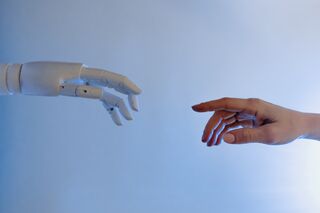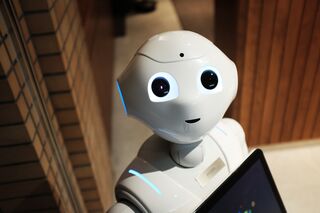Relationships
When Technology Becomes a Romantic Partner
"No matter how we feel about it, we have to discuss it."
Posted April 17, 2022 Reviewed by Devon Frye

Many of us already feel very comfortable asking Amazon’s Alexa to play a song we like, answer simple questions, or remind us about important events. The COVID-19 pandemic taught us all how fast we can move our human-to-human interactions online and how quickly we can adapt to connecting with our loved ones using technological means. How far can it go from here?
No longer playing the matchmaker, technology is now making the transition to a relationship partner and becoming an independent actor, no matter its creators’ intentions.
In order to understand the changes we are experiencing now, it is helpful if we first examine the evolution of relationships from early prehistoric times until today. If we understand how technology impacted human beings in the past, we might get some insight into how other developments will influence us in the future. Moreover, awareness of the various forms of relationships from the past might open our eyes to the different meanings and variations they might carry in the future. Relationships need not be tied to the common models found in recent history and might evolve as technology develops.
Historic Transformations of Relationships
For this reason, in Relationships 5.0, four significant periods in human history are surveyed, each of which signifies a fundamental technological development. The first is Hunter-gatherer society (Society 1.0), which was based on the basic technologies of hunting, gathering, fishing, and scavenging. The second is agricultural society (Society 2.0), which was based on the technology of farming. The third is industrial society (Society 3.0), which was based on innovations such as the steam engine, electricity, and manufacturing processes. The fourth and most recent is information society (Society 4.0), based on computers and the Internet.
Sequentially, these previous technological changes deeply influenced personal relationships. While the clan stood at the center of society in prehistoric times and relationships were more fluid (Relationships 1.0), the multigenerational family was dominant in the agricultural period (Relationships 2.0), the nuclear family rose to importance with industrialization (Relationships 3.0), and networked individualism was highly influential in the information age (Relationships 4.0).
Even the most radical researchers do not argue that all humans felt the same way and bonded with each other similarly across all cultures and societies living in the same era. The argument here is more modest: There is a tendency toward one relationship type that is more dominant in each era, and this tendency was greatly influenced by technology.

We are now entering the fifth evolution of society. The term “Society 5.0” was coined in 2016 by the Japanese government to describe the next stage of human development, in which significant advances in robotics, biotech, artificial intelligence, quantum computing, cyber-physical systems, and nanotech all combine to revolutionize the ways we live. The main difference in this transition can be described as moving from technologies used as tools controlling human surroundings and work to technologies that are our ecosystem in and of themselves.
The “Super Smart” society, or Society 5.0, makes technology embedded in human life and able to co-exist independently from us. In turn, we are expected to experience seismic shifts equal in magnitude to the previous greatest changes in civilization.
I argue that the manifestation of these technologies and their integration into our personal relationships signal the beginning of the fifth form of relationships and a new reality in which relationships are formed and maintained in radical new ways. I call this new reality Relationships 5.0.
Even though we are unlikely to witness the widespread proliferation of human-tech relationships in the near future, I show through numerous studies and surveys others and I conducted that the answer to the question of whether these relationships are forthcoming is a resounding “yes.” The vision of technology satiating our emotional, intellectual, and physical needs is no longer limited to science fiction.
To make this argument, it is not enough to argue that there are “great new inventions” about which we are all excited. For example, some use the term “Fourth Industrial Revolution” to distinguish the developments of the last few years from those associated with technological developments in the late 20th century. But some of the technologies associated with the Fourth Industrial Revolution cannot be considered transformative for relationships.
Take three-dimensional (3D) printing as an example. 3D printing is considered part of the Fourth Industrial Revolution because it, among other uses, has revolutionized how we manufacture goods. It has significantly reduced the barriers between markets and inventors and disrupted the process of technological advancement by allowing budding entrepreneurs to prototype new inventions faster. In other cases, 3D printing contributes to the creation of small medical implants produced on demand, exactly tailored to an individual patient.
However, while 3D printing might be transforming industry-related factors, it has little to do with how we bond with each other. In perhaps the best-case scenario, someone could design and print a beautiful, creative, and original gift for their significant other. Although this may bring joy to their relationship, it would not change the very foundations of their connection.

Therefore, we must consider which technological advances might impact us so much that we will think differently about our family lives, love affairs, and emotional needs. Only changes that are radical and comprehensive enough to impact our emotions and attachments patterns will be considered. Even then, we should examine their effects in the field, among real people, and using rigorous empirical methods. In this way, we will be able to understand the nuances of Relationships 5.0 and the extent to which our lives are likely to change.
We should thus identify and discuss three technological changes—we can even call them revolutions—relevant to relationships. The first and perhaps the most important one is the cognitive revolution (artificial intelligence); the second is the sensorial revolution (virtual reality and augmented reality); and the third is the physical revolution (robots).
These three revolutions combine to imitate three central aspects of human dynamics that, if replaced by technology, can change our personal relationships in significant ways. The cognitive revolution is changing the way we converse with technology, the sensorial revolution is changing the limits of the sights and sounds we experience through technology, and the physical revolution is changing the ways in which we are assisted by technology, whether the tasks involve moving, touching, cleaning, or even receiving hugs and physical warmth.
No matter how we feel about these developments, we must start discussing them.
Facebook image: Bangkok Click Studio/Shutterstock




